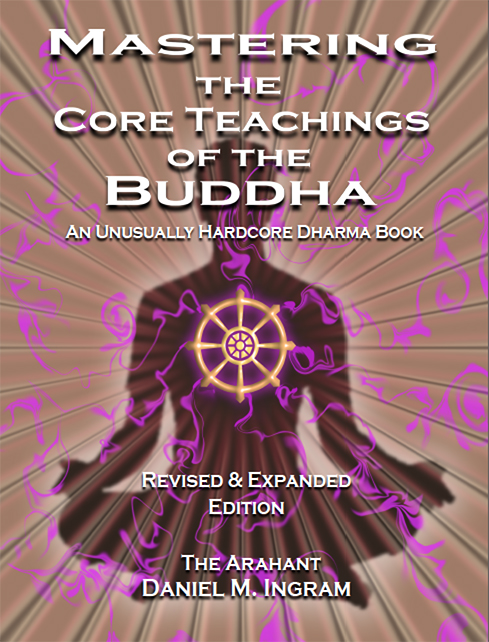66. Made Pliant and Malleable
← 65. How to Cultivate the Powers | 67. Benefits of the Powers →
Most people generally don’t get their concentration strong enough to get to the stage that is described in the old texts by the standard phrase “the mind made pliant and malleable”, but if they do, they will be richly rewarded. Someone practicing hard jhana all day long with few breaks except to bathe, eat, wash, use the bathroom, and sleep may, if they have talent and diligence, be able to accomplish this level of concentration in a few weeks or perhaps a few months. Success would also depend on many factors of the practitioner, practice, and setting that are hard to quantify. Talking and other interactions rapidly dissipate momentum.
In the malleable phase, whatever you turn your intention towards just shows up, with the qualifier that some magickal feats will be easier for some than others. You want red flowers to appear in your room, they are suddenly there, or so it seems. You want to draw runes in the air in blue flame with your finger, and that slow, thick, slightly delayed, syrupy flame just rolls off your fingers onto space like you always imagined it would, and the runes hang there like something out of a fantasy movie. You want to jump out-of-body off the cushion and soon enough off you go, and from there anything you can imagine experiencing can be experienced (advice: formally intend destinations and activities before getting out, which is good general advice for all of the siddhis).
You wish to see and feel the energy channels and chakras, and suddenly there they are in your body, manipulable, tunable, bright, and obvious. You wish everything in your field of vision to turn green, and suddenly green is everywhere, coloring everything. You wish to create a hyper-detailed visualization of something, and it appears in the space in front of you with a level of precision you never could have imagined. You wish to hear sounds far away or see sights far away, suddenly they show up, clear and surprising, as if you just tuned a radio. You are interested in past life experiences, and a stream of bubbles trails out into space, each containing a vast amount of information about who it seems you were in various previous existences, often with some information about how the entities apparently died. You do loving-kindness practices, and you not only feel your whole world filled with that feeling, but you might even see it shining out like light to all beings.
The first time I got to the level of pliant and malleable was about twelve days into a retreat on which I was using the fire kasina (candle flame practice) and a mantra together. I was already a relatively strong practitioner at that point, in what I think of as the middle stages of awakening, and had as my baseline solid access to the formless realms with minimal set-up in daily life. My daily-life practice during that time included rising from the first to the eighth jhanas at least once per day, usually just before going to sleep, and that foundation helped speed things along.
On a retreat about two years later I got to the pliant and malleable level again, but this time got there based mostly on the momentary concentration of pure insight practices, perceiving everything in the whole field coming and going very strongly second after second, minute after minute. After about two weeks, suddenly there it was, that amazing malleability of mind and reality that is so far beyond what is ordinarily possible. As this is not something you hear many people describing, it is hard for me to get a good sense of exactly how common or easy this may be in general, and how that general data would apply to you is anyone’s guess. Regardless, the basic knowledge that such a level can be experienced at all can help people attain it. This is the stage where you can really see what the world of the siddhis is about, including the amazing, the good, the bad, and the ugly. There is a wide range of very strange and sometimes downright creepy and disturbing stuff that can happen when the powers are taken to this intensity.
As stated earlier, and worth repeating here in case you didn’t read the preceding section on concentration in Part One, strong concentration is a tool, and tools can be dangerous. When your concentration gets strong, guard the mind well, which means guard the speech and body as well, since wherever the mind turns, things happen and can happen fast. Thus, just as an ultra-powerful sports car driven fast is quite the party, just so, one small slip of the steering wheel can end in catastrophe. So, regarding the ultra-concentrated mind: use it well, enjoy it, and carefully keep it on track. If it starts to get unstable or suddenly veers down strange, alarming, and/or harmful tracks, correct it quickly and hold it on course.
More specifically, if you are doing a powerful concentration retreat with or without the powers, I highly recommend that you keep this paradigm firmly in mind, and formally remind yourself daily to keep your thoughts and actions non-harming and benevolent. This is great advice on any sort of retreat at all. As the noble eightfold path enumerates, there is right concentration and there is wrong concentration. Stick to the right side, please. You are the worst victim of your mind’s wrongly, hurtfully, or unskillfully used concentration.
That said, rather than consciously work to this level of strong and fluent mastery, most people chance into these experiences and apparent abilities spontaneously as their concentration suddenly peaks for some brief period and a mysterious convergence of seeds and circumstances aligns to give them a brief burst of something far beyond their ordinary ability. Such glimpses often never show up again or perhaps will do so only many years later. Some will chance onto a few narrow abilities that they can access more easily, with some practice, and, for a lucky few, as easily as breathing.
I consider myself a well-traveled tourist in the realm of the more formal and dramatic end of the siddhis, but a tourist nonetheless. I can visit, have visited often in fact, but don’t live there, at least not on the exotic end of things, and am not much of a native. One exception is lucid dreaming, which I loosely lump into this category, and have been doing since I was about five years old. Another exception is having unusual amounts of energy on tap. However, I know a rare few people who do live there much more fully; these real natives of the siddhis territory grew up in it just like I grew up able to lucid dream. Yet they have much more than just lucid dreaming as their baseline. Since the powers are natural for them, they are as comfortable with them as any capability that dates back to their childhood.
However, for us tourists, and sometimes even for the natives, it is common to find something disturbing or distracting about the powers. For those who find the siddhis happening more easily in daily life, or occurring frequently in their formal meditation practice when they didn’t intend to have them, they can often get them to go away just by resolving that they go away, as well as by not giving them any attention, and then they will generally fizzle out. Just as strong intent and formal or voiced resolutions can get us into the powers, just so they can be used to get us out of them—most of the time, anyway. Just as a car is useful because it has a steering wheel, a gas pedal, a brake pedal, an emergency brake, and an ignition switch that can turn it on and off, just so with the powers. I personally would not drive a car that did not have all those parts functioning properly. I recommend the same with the powers.
I have dharma friends who have very strong concentration abilities who have explored the powers, but there is good reason that many of these seasoned and mature practitioners who can go there generally will not, as tempting as it can sound. The same applies to me. When I have gotten into some of the more exotic powers, the immediate effect has been to cause me to back off immediately and contemplate for a long time before going there again, assuming I ever went back, which I often did not. For those who haven’t experimented with the powers but do want to, this may seem surprising. I suspect those who are reading this who have explored the powers will be nodding knowingly here. It is not that there aren’t fascinating and occasionally useful aspects to this territory, but if you play with the powers much, it is very likely you will soon see what I mean about why you might not want to go there without very solid training in sila, samadhi, and pañña. My more Mahayana-influenced friends warn of going there without strong training in the two bodhicittas.
← 65. How to Cultivate the Powers | 67. Benefits of the Powers →

